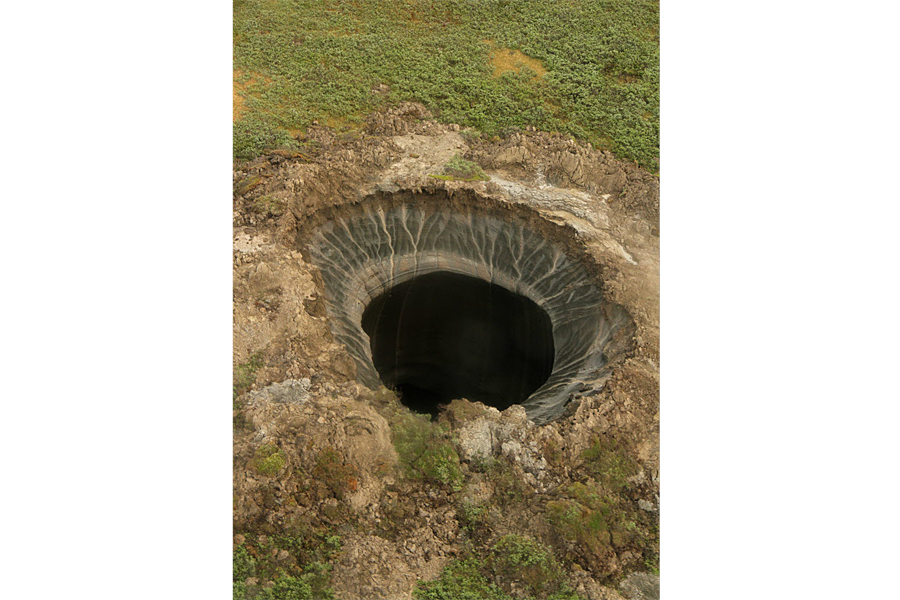Mysterious Russian holes: Is Earth becoming perforated?
Loading...
Siberian reindeer herders literally stumbled upon a scientific mystery when they found a deep, gaping hole in the Earth.
While walking along their pasturing route, the herders nearly plummeted into a rabbit hole about about 13 feet wide and an estimated 200 to 330 feet deep.
But this crater was probably not formed by a rabbit. In fact, it is the third of similarly mysterious holes found in the past month in northern Russia.
This new hole, found in the Taymyr Peninsula, may help scientists uncover the cause of these bizarre openings in the Earth. Researchers and bystanders have proposed many conflicting theories as to the cause of the first two holes, which were made known earlier this month, in the Yamal peninsula. Some suggest the holes may be the result of missile testing, while others insist a fiery ball crashed into the Earth from outer space.
But Russia doesn't hold exclusive rights to humongous holes in the ground
These holes may seem to indicate that northern Russia is rapidly becoming a giant Swiss cheese wheel, but other places have their fair share of perforations.
In 2010, a huge hole opened up in Guatemala City after heavy rains from a tropical storm. This sinkhole, at about 100 feet deep and 65 feet across, was the second of its kind in the nation. Both times, researchers blamed a burst water pipe below the streets, causing the hole that swallowed up much of its surroundings.
But at over 980 feet wide and 410 feet deep, the Great Blue Hole, a popular diving spot in Belize, could swallow all of these holes whole. This hole was originally formed as a limestone cave during the last ice age. When the ice melted and the sea rose, the cave filled with ocean water.
But are these Russian holes sinkholes? No, say researchers.
"We can be certain in saying that the crater appeared relatively recently, perhaps a year or two ago; so it is a recent formation, we are not talking about dozen years ago," Andrey Plekhanov, senior researcher at the State Scientific Centre of Arctic Research, told the Siberian Times after examining the first crater.
The research team had taken soil and ice samples from the site, explained Dr. Plekhanov, and "we are working with space photographs to figure out exact time of its formation."
What could have happened?
"According to local residents, the hole formed on 27 September 2013," a local lawmaker, Mikhail Lapsui, told the Siberian Times following a helicopter ride over the second hole. "Observers give several versions. According to the first, initially at the place was smoking, and then there was a bright flash. In the second version, a celestial body fell there."
In addition to the possibility of meteorites, potential explanations include rogue missiles, side effects of natural gas drilling, an extremely elaborate prank, and alien spacecraft.
Researchers initially knew the Russian formations were not sinkholes, like in Guatemala, because it has mounds of dirt around the holes' rims. Instead of the Earth collapsing inward, in Russia material seems to have been flung from the hole during some sort of underground explosion.
Could it have been a meteorite? After all, one did explode over Russia last year. Perhaps these holes could have come from pieces associated with that same impact. The presence of ejected material around the rim does not rule that out, as such an impact is known to catapult earth out from the crash location.
But scientists think that they were more likely caused by an underground eruption.
Marina Leibman, chief scientist at the Earth Cryosphere Institute in Siberia, told Andrew Revkin of the New York Times' Dot Earth section, that she initially thought the first hole was the result of gas drilling. But she quickly found it was not.
Plekhanov told The Siberian Times, "If it was a man-made disaster linked by gas pumping, it would have happened closer to the gas fields." As the fields are about 18.6 miles away from the location, "Gas workers would have been on alert, letting us know immediately."
Were they caused by global warming?
Dr. Leibman, Plekhanov, and other researchers believe the holes are the result of an eruption of a methane gas pocket, prompted by thawing permafrost.
Deep below the surface in Siberia is a mix of ice, water, and soil. As the land heats, this mixture warms too. And as it warms, methane is released, building pressure against its surroundings. Eventually, the pressure increases until it blows, throwing aside everything in its way and forming a hole like these three.
Leibman says this formation may lead to a new lake. In the heat of the summer, the permafrost walls of the hole are melting and water is trickling down to pool at the bottom. If this continues and the flow increases, Siberia may see some new lakes.
But researchers have only scratched the surface.
"Could it be linked to the global warming? We have to continue our research to answer this question, said Plekhanov. "Two previous summers – years 2012 and 2013 were relatively hot for Yamal, perhaps this has somehow influenced the formation of the crater. But we have to do our tests and research first and then say it more definitively."








